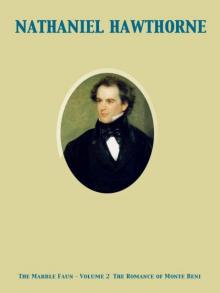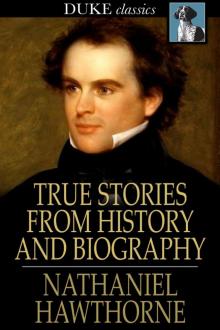- Home
- Nathaniel Hawthorne
Scarlet Letter (Barnes & Noble Classics Series) Page 2
Scarlet Letter (Barnes & Noble Classics Series) Read online
Page 2
After witnessing her former lover’s decline, Hester determines that she will reveal Chillingworth as her husband to Dimmesdale so she can warn the reverend of Chillingworth’s malicious design. She waits for Dimmesdale one day in the forest, where no one will see them. For Hester, their meeting is a release of the passion she has continued to feel for Dimmesdale since the time of their affair. Hester is desperate in this scene to assuage her former lover’s misery, not only out of concern for his well-being, but also because she wants him to accept her and her child into his life. She says of their affair, “What we did had a consecration of its own,” an apparent reference to Pearl that borrows religious terms to describe what Dimmesdale views as an offense against his faith. Dimmesdale’s response is far more equivocal: He initially chastises Hester for having caused him to stray, then blames Chillingworth for his miserable emotional state. Lastly, while he lacks the courage to propose the plan himself, he insinuates his desires to Hester, then passively accedes when she at last expresses the same desire—one that she kept hidden for seven years: that she, Dimmesdale, and Pearl leave Boston to live together as a family. Their happy plans never come off. When Hester confirms that the three of them will sail for Europe after the election-day sermon Dimmesdale will give, she learns that Chillingworth has booked passage aboard the same ship. But the father, mother, and child are never to board that ship together, for, after delivering the Election Sermon, the Reverend Dimmesdale takes Hester and Pearl with him onto the pillory to reveal his crime. Before the crowd, he exposes the stigmata that have broken out on his breast in the shape of the letter A. He then dies with his head resting on the scarlet letter.
Although the mark of Hester’s crime is stitched in red across her breast, emblazoned in stigmata across the breast of her lover, and broadcast across the sky, Hawthorne never names her crime in The Scarlet Letter. The novel’s title alludes to, but does not reveal, the letter A, which itself suggests, but does not divulge, the crime of adultery. By the time Roger Chillingworth, concealing his relationship to Hester when he wanders into the crowd during her exposure, inquires of a spectator “wherefore is she here set up to public shame,” the two symbols of Hester’s crime—the scarlet letter A and the baby Pearl have all but revealed its nature. But the scarlet letter remains the fullest articulation of the crime, for Roger Chillingworth interrupts before the spectator has done more than insinuate the transgression that gives rise to the spectacle of public shame.
If The Scarlet Letter evokes Hester’s crime without naming it, the novel tells almost nothing about Hester and Dimmesdale’s affair. During the reverie that briefly distracts her from the hideous spectacle of which she is the center, Hester recalls in sequence her childhood home, her father and mother, her own youthful likeness, and the early days of her marriage, but in her remembrance she skips over the time from her adulterous encounter with Dimmesdale to her present circumstance, as she stands at the pillory. Possibly Hester and Dimmesdale consorted with initially innocent intentions after one of his sermons, although it is difficult to imagine Hester, even before her fall, as so devoted to Bible studies that she would seek or elicit her minister’s private tutelage. Nothing in the novel, apart from what the reader can glean from the natures of Hester and Dimmesdale, permits the inference that the couple had an enduring affair, although nothing contradicts this possibility, either. But by the time the novel opens, and even more so by its close seven years later, the characters are so transformed that the reader can hardly draw informed conclusions about their earlier selves. Despite the novel’s frequent references to Dimmesdale’s repressed passion, a sexual encounter between Hester and him seems as remote from the events described in the novel as the Puritan penal system is from contemporary mores. In Studies in Classic American Literature (see “For Further Reading”), D. H. Lawrence assumed that Hester seduced Dimmesdale, an explanation that renders the act of adultery more plausible, but not any easier to imagine. Depriving his readers of the means of imagining the event that triggers Dimmesdale’s unraveling, Chillingworth’s vendetta, Pearl’s birth, and Hester’s disgrace seems to be a deliberate part of Hawthorne’s artistic design.
The crime that gives the novel its name and preoccupies all of the characters, then, is shrouded as much by the symbolism that overshadows the thing symbolized as by the shame of the characters. Without an account of the criminal act, readers of The Scarlet Letter apprehend Hester’s crime through the refracted light of multiple moral perspectives. In that he is Hester’s creator, Hawthorne’s view of Hester’s crime is at least interesting, if not determinative of how readers of his day, or of ours, should respond. The narrator and the Puritan community both overtly pass judgment on Hester’s act, although the former vacillates in the harshness with which he judges her. In addition, each of the three important adult characters—Arthur Dimmesdale, Roger Chillingworth, and Hester Prynne—present a particular response to Hester’s adultery that may inform our own. The fourth important character, Pearl, though a child and only intuitively aware of the crime, offers an additional perspective as well as a real challenge to a response of unmediated censure, for if the Puritans cannot qualify their judgment of Hester’s crime, they cannot acknowledge what Hester calls its “consecration.” Though the perspectives of Hawthorne, the novel’s narrator, the community, and each of the novel’s four main characters say more about these individuals and their Puritan society than about adultery, each perspective contributes to the reader’s multidimensional experience of the novel’s central, unmentionable event.
Perspectives on Hester’s Crime
Hawthorne’s ambivalence toward his Puritan ancestry complicates the attempts to understand his response to Hester Prynne, her act of adultery, and the punishment inflicted on her. In the novel’s introductory section “The Custom-House,” Hawthorne refers to the “stern and black-browed Puritans” who were his forebears: William and John Hathorne, the author’s great-great-great grandfather and great-great-grandfather, who lived in Salem during the mid-1600s. These men were magistrates, and the records of early Massachusetts history, with which Hawthorne was acquainted, contain accounts of each of these men inflicting humiliating and often brutal sentences. The elder Magistrate Hathorne, for example, sentenced a burglar to having his ear lopped off and the letter B branded onto his forehead.
But the notoriety of the Hawthorne forebears derives primarily from their treatment of women. In their roles as magistrates and Puritan patriarchs, the Hathornes had no squeamishness about inflicting physical punishments on women for their religion, sexual behavior, and, most infamously, supposed practice of witchcraft. The reference in “The Custom-House” to the “incident of [William Hathorne’s] hard severity towards a woman” relates to the treatment of a Quaker woman, who was tied half-naked to the back of a cart and flogged ten times each in Boston, Salem, and Dedham, at the honorable William Hathorne’s direction. The Records of the Salem Quarterly Courts of Essex County, Massachusetts (Salem, 1914; vol. 4, p. 84) reveals a sentence issued by William Hathorne against an erring woman in November of 1668:
Hester Craford, for fornication ... as she confessed, was ordered to be severaly whipped and that security be given to save the town from the charge of keeping the child.... The judgment of her being whipped was respitte for a month or six weeks after the birth of her child, and it was left to the Worshipful Major William Hathorne to see it executed on a lecture day.
This passage likely influenced Hawthorne’s choice of name for his heroine in The Scarlet Letter. William Hathorne’s fifth son, John, added to the notoriety of the family name in his role examining many of those accused of being witches during the Salem witchcraft trials of 1692, a role he never repented even when other magistrates who served on the same panel expressed their remorse. Most of those accused and executed as witches were women. Hawthorne describes his feelings about his Hathorne ancestors with a mix of horror, awe, and kinship, asking that he not be cursed for their deeds, at the same time imagining
their disdain for their descendant and noting that “strong traits of their nature have intertwined themselves with mine” (p. 11). Critics generally take the Hawthorne’s addition of a w to his ancestral name as evidence of a desire to distance himself from his ancestors; possibly, though, Hawthorne sought to spare the Hathornes the association with his literary career, which he characterized in “The Custom-House” as a source of ignominy.
Hawthorne’s relationship to William and John Hathorne is similar in its ambivalence to that of the narrator of The Scarlet Letter to the Puritan patriarchs who impose sentence on Hester Prynne. In describing the Boston governor and the assemblage of elders who preside over the exposure of the scarlet letter, the narrator vacillates between qualified praise and open dissent:
[Governor Bellingham] was not ill fitted to be the head and representative of a community, which owed its origin and progress, and its present state of development, not to the impulses of youth, but to the stern and tempered energies of manhood, and the sombre sagacity of age; accomplishing so much, precisely because it imagined and hoped so little. The other eminent characters, by whom the chief ruler was surrounded, were distinguished by a dignity of mien, belonging to a period when the forms of authority were felt to possess the sacredness of divine institutions. They were, doubtless, good men, just, and sage (p. 55).
The narrator’s view of Hester’s crime is as complicated as his view of her persecutors. While observing the unsuitedness of the Puritan patriarchs to pass judgment on Hester’s crime, and commenting on the cruelty and coarseness of the Puritan crowd that gathers before the prison house, the narrator repeatedly refers to Hester’s crime as a sin, or a transgression of basic morality, rather than an infraction against the mores of a particular culture during a particular period.
In contrast to the complicated, internal response of Hawthorne’s narrator and likely Hawthorne himself, the Puritan community responds in a manner that is fully public and only modestly nuanced. This response immediately eclipses the crime and its immediate consequences in the first months following the act of adultery. The reader never learns when or how the crime is exposed, the event that presumably initiates Hester’s confinement in prison, because Hawthorne makes the punishment the novel’s opening scene, before the reader knows the nature of the crime. But the community inflicts a punishment even more devastating to Hester than the official sentence of humiliation and exposure: Her expulsion from human society drives Hester to lawless and nihilistic reveries, and Pearl to sociopathic defiance.
From the novel’s beginning, however, individuals in the community show the compassion that is absent from the magistrates’ sentence. While gathered to witness Hester’s exposure, five matrons, well fed on “the beef and ale of their native [England], with a moral diet not a whit more refined,” expound on the appropriate punishment for Hester. Four of the matrons agree that Hester’s official sentence is too lenient, and advocate branding her with a hot iron or death, the sentence associated with the crime of adultery in both the New England statutes of the 1640s and in the Bible. But one woman, who, like Hester, is young and has a child in her charge, imagines Hester’s humiliation and responds sympathetically, enjoining her companions to silence to protect Hester from hearing their cruel judgment.
This lone voice of sympathy, coming from a spectator who is more nearly a peer to Hester, sharing with her the circumstances of youth and motherhood, seems a fitter judge than the patriarchs who assemble to witness the execution of Hester’s punishment, and who are so removed from Hester in their age, gender, and passionless rigidity. The narrator comments on these men after John Wilson, a clergyman among them, calls to Hester to demand that she reveal Pearl’s father:
But, out of the whole human family, it would not have been easy to select the same number of wise and virtuous persons, who should be less capable of sitting in judgment on an erring woman’s heart, and disentangling its mesh of good and evil, than the sages of rigid aspect towards whom Hester Prynne now turned her face. She seemed conscious, indeed, that whatever sympathy she might expect lay in the larger and warmer heart of the multitude (p. 55).
The narrator inserts throughout the novel observations on the natures of the characters and their actions that mix compassion and insight with an unquestioning conviction that a serious wrong has occurred. The narrator’s view of the Puritan elders is especially apt, for though the patriarchs mitigate Hester’s sentence from the one prescribed by statute, their reasons for doing so relate to her lover’s transgression and the wrong done to her husband, rather than to the circumstances of Hester’s character or actions that might place her crime in a less culpable context. The magistrates seem to judge her solely by her effect on the two men implicated in the adulterous triangle. Accordingly, they spare her from death for two reasons. Hester’s youthful beauty leads them to surmise she was “doubtless strongly tempted to her fall.” In addition, they believe Hester’s husband, the victim with whom the panel of patriarchs is most likely to empathize, is dead, and so the offense against him is perhaps less.
As time passes, the Puritan community proves more inclined to judge Hester by the sum of her actions than are its elders, who have the same prejudices as the community, only “fortified in themselves by an iron framework of reasoning” (p. 134). The disjunction between the organic ability of the community to mediate its view of the crime through appreciation of the criminal’s subsequent acts and the greater intransigence of mostly aged, conservative, and male statesmen of the community is strangely prescient of a recent episode in American history involving President Bill Clinton and an intern. But the passage of time does not diminish, and for Dimmesdale, at least, only exacerbates, the effect in the minds of the characters most intimately affected by the crime.
Dimmesdale is the character most devastated by his role in the crime, which is, of course, that of coadulterer. Dimmesdale has sinned according to his own system of beliefs; to his credit, he does not tailor or dilute his belief system to accommodate what he has done. Dimmesdale’s religiousness is genuine, and while his English heritage and inhibited passion set him apart from the Puritan elders “amongst whom religion and law were almost identical” (p. 43), his religious faith is nonetheless uncompromising concerning the sin he has committed. Understood as a reaction to a violation of faith, rather than law or even morality, Dimmesdale’s response is, even by today’s standards, neither disproportionate nor dated. Laws supposedly reflect social mores, and they change to mirror changing opinions about the inherent wrong in certain behaviors, the threat of a particular behavior to society, and reasonable responses to behaviors deemed worthy of punishment. Religion, reason, and public mores no doubt influence one another, but in ways that are complicated and rarely direct. Whether Dimmesdale’s response to his violation of faith is reasonable is irrelevant; his anguished response is authentic and timeless.
Faith is cause enough for Dimmesdale’s torment, but other factors compound his misery. Although he flagellates himself, he cannot allow himself to borrow another means of atonement from the Catholic faith, namely, confession. When Hester meets him in the forest to divulge Chillingworth’s identity, Dimmesdale justifies his failure to confess his crime:
Of penance I have had enough! Of penitence there has been none! Else, I should long ago have thrown off these garments of mock holiness, and have shown myself to mankind as they will see me at the judgment-seat (p. 159).
Immediately, Dimmesdale contradicts himself by relating his misery to the concealment of his crime:
Happy are you, Hester, that wear the scarlet letter openly on your bosom! Mine burns in secret! Thou little knowest what a relief it is, after the torment of a seven years’ cheat, to look into an eye that recognizes me for what I am! (p. 159).
In this scene, Dimmesdale seems to talk himself into at last confessing his crime. He does so only after delivering the most inspired sermon of his career, the Election Sermon, thus postponing his spiritual salvation so as not to interfer
e with the climax of his professional career. Dimmesdale’s inner torment derives in part from the knowledge that the confession necessary to purge his soul will dash his professional aspirations.
Like Dimmesdale, Chillingworth conceals his relationship to the adulterous act. Unlike Dimmesdale, who turns his anguish inward upon himself, Chillingworth focuses his misery upon an outward target. Chillingworth determines to prolong his rival Dimmesdale’s agony by ministering to his physical health while insinuating himself into the minister’s interior life, where Dimmesdale seeks to keep his secret buried. But Chillingworth’s efforts to relieve his misery by transferring it to another wear on him in the same way Dimmesdale’s efforts to conceal his relationship to Hester and Pearl destroy the reverend. When Hester confronts Chillingworth to abandon her promise to keep secret his identity as her husband, she observes the ugly transformation effected by his seven years of obsession with finding, then destroying, her coadulterer: “In a word, old Roger Chillingworth was a striking evidence of man’s faculty for transforming himself into a devil, if he will only, for a reasonable space of time, undertake a devil’s office” (p. 140). Though Hester has no passionate memories of Chillingworth, her memories from her married life are of a decent man. The fiend that drives Dimmesdale to his death—or hastens Dimmesdale’s death, as Dimmesdale’s health has already deteriorated before he ever encounters Chillingworth—has also driven out the gentle scholar, leaving a man as misshapen morally as he is physically. Chillingworth dies within a year of Dimmesdale’s death, as though only the fiend remained of the old man, and without a victim to feed on, the fiend could no longer survive.

 The Scarlet Letter
The Scarlet Letter Young Goodman Brown : By Nathaniel Hawthorne - Illustrated
Young Goodman Brown : By Nathaniel Hawthorne - Illustrated The Birthmark
The Birthmark The Marble Faun; Or, The Romance of Monte Beni - Volume 1
The Marble Faun; Or, The Romance of Monte Beni - Volume 1 The Minister's Black Veil
The Minister's Black Veil The Great Stone Face, and Other Tales of the White Mountains
The Great Stone Face, and Other Tales of the White Mountains The House of the Seven Gables
The House of the Seven Gables The Snow Image
The Snow Image The Blithedale Romance
The Blithedale Romance Rappaccini's Daughter: By Nathaniel Hawthorne - Illustrated
Rappaccini's Daughter: By Nathaniel Hawthorne - Illustrated Twice-Told Tales
Twice-Told Tales Twice Told Tales
Twice Told Tales The Marble Faun; Or, The Romance of Monte Beni - Volume 2
The Marble Faun; Or, The Romance of Monte Beni - Volume 2_preview.jpg) Footprints on the Sea-Shore (From Twice Told Tales)
Footprints on the Sea-Shore (From Twice Told Tales) Main Street
Main Street_preview.jpg) The Seven Vagabonds (From Twice Told Tales)
The Seven Vagabonds (From Twice Told Tales) Fanshawe
Fanshawe Chippings with a Chisel
Chippings with a Chisel Selected Tales and Sketches
Selected Tales and Sketches Young Goodman Brown
Young Goodman Brown Roger Malvin's Burial
Roger Malvin's Burial The Prophetic Pictures
The Prophetic Pictures The Village Uncle
The Village Uncle Scarlet Letter (Barnes & Noble Classics Series)
Scarlet Letter (Barnes & Noble Classics Series) The Procession of Life
The Procession of Life Drowne's Wooden Image
Drowne's Wooden Image Hawthorne's Short Stories
Hawthorne's Short Stories My Kinsman, Major Molineux
My Kinsman, Major Molineux Legends of the Province House
Legends of the Province House Foot-Prints on the Sea-Shore
Foot-Prints on the Sea-Shore The Haunted Quack
The Haunted Quack Tanglewood Tales
Tanglewood Tales The Seven Vagabonds
The Seven Vagabonds Mosses from an Old Manse, Volume 2
Mosses from an Old Manse, Volume 2 The Canterbury Pilgrims
The Canterbury Pilgrims Wakefield
Wakefield The Gray Champion
The Gray Champion The White Old Maid
The White Old Maid The Snow-Image: A Childish Miracle
The Snow-Image: A Childish Miracle The Gentle Boy
The Gentle Boy Mr. Higginbotham's Catastrophe
Mr. Higginbotham's Catastrophe![The Threefold Destiny: A Fairy Legend, by Ashley Allen Royce [pseud.] Read online](http://i1.bookreadfree.com/i2/04/10/the_threefold_destiny_a_fairy_legend_by_ashley_allen_royce_pseud__preview.jpg) The Threefold Destiny: A Fairy Legend, by Ashley Allen Royce [pseud.]
The Threefold Destiny: A Fairy Legend, by Ashley Allen Royce [pseud.] Lady Eleanore`s Mantle
Lady Eleanore`s Mantle The Great Carbuncle
The Great Carbuncle The Portable Hawthorne (Penguin Classics)
The Portable Hawthorne (Penguin Classics) True Stories from History and Biography
True Stories from History and Biography